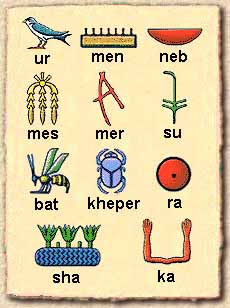

A brilliant young French scholar named Jean Francois Champollion
used his knowledge of ancient Greek to read the Rosetta Stone. He had translated
the mysterious Hieroglyphs at last.


THE ROYAL CARTOUCHE
To emphasize royal or holy names, the Egyptians wrote
hem in a frame called a Cartouche. Champollion used Cartouches on the Rosetta
Stone to help him translate the Hieroglyphs.
NEW TEXTS
The last Hieroglyphic inscription was carved in Philae
in AD394. Old Egyptian writing then died out. Instead, people used an alphabet
called Coptic. The name comes from an Arabic word, gubti, based on the
Ancient Greek name for Egypt.
WRITING PAPER
As well as carving and painting Hieroglyphs on walls
and stone tablets, the Egyptians also used paper used from papyrus, a type
of reed. The inside part of the papyrus stem was made into long sheets
of paper by soaking and pressing. Many papyrus have survived to his day,
preserved by the hot sun and sand of Egypt.
HEAVENLY GUDE BOOKS
Inscriptions in Hieroglyphs were found in the pyramids.
These were believed to help the king move easily into the Next World. They
consisted of prayers, pleas and ritual pronouncements to the gods. It was
hoped that the gods, such as Anubis would welcome the king and allow him
to live a new, happy and everlasting life in the Next World.